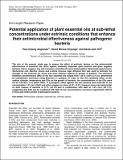| dc.contributor.author | Paul Oyieng Angienda, David Miruka Onyango, David Jack Hill | |
| dc.date.accessioned | 2020-08-27T12:25:50Z | |
| dc.date.available | 2020-08-27T12:25:50Z | |
| dc.date.issued | 2010-08-18 | |
| dc.identifier.citation | 32 | en_US |
| dc.identifier.uri | https://repository.maseno.ac.ke/handle/123456789/2471 | |
| dc.description.abstract | The aim of the present study was to assess the effect of extrinsic factors on the antimicrobial effectiveness of essential oils (EOs) against medically important gram positive and gram negative bacteria. Clove, oregano, bay and cinnamon essential oils were tested against Salmonella typhimurium, Escherichia coli, Bacillus cereusand Listeria innocua. Agar diffusion test was used to estimate the strength of the essential oil. Clove was most effective against all groups of bacteria. The minimum inhibition concentrations (MIC) of the four essential oils ranged from 1.25 to 3.50% (v/v) as determined by turbidimetric technique using Biocreen C, analyzer. In order to test the combined effect of pH, sodium chloride, temperature and EOs on the growth of bacteria, the concentrations of the EOs were set at 0.03125% (v/v) below MICs. A synergistic effect against the test bacteria was achieved at the concentration 1.2% (w/v) NaCl and either oregano or clove oil (P < 0.01), however clove was bactericidal on both classes of bacteria at 37°C, pH 5.5 and in combination with NaCl at 1.8% (w/v) pH (7.3), suggesting that EOs can be combined with NaCl at low concentrations overcome organoleptic effects in food and inhibit growth of pathogenic bacteria. | en_US |
| dc.publisher | Academic Journals | en_US |
| dc.subject | Antimicrobial, bacteria, essential oils, extrinsic factors. | en_US |
| dc.title | Potential application of plant essential oils at sub-lethal concentrations under extrinsic conditions that enhance their antimicrobial effectiveness against pathogenic bacteria | en_US |
| dc.type | Article | en_US |

